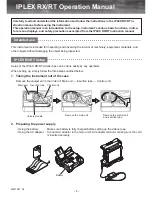
Quadrupole mass filter
3-9
SRS Residual Gas Analyzer
free path of the ions.
The general principle of operation of the filter can be visualized
qualitatively
in the
following terms: One rod pair (X-Z plane) is connected to a positive DC voltage upon
which a sinusoidal RF voltage is superimposed. The other rod pair (Y-Z plane) is
connected to a negative DC voltage upon which a sinusoidal RF voltage is superimposed,
180 degrees out of phase with the RF voltage of the first set of rods. The potentials are
represented by the expression:
V
x/y
= +/- (U + V
0
cos
Z
t)
where,
U is the magnitude of the DC voltage applied to either pair of rods,
V
0
is the amplitude of the RF voltage applied to either set of rods, and
Z
is the angular frequency (=2
S
f) of the RF.
Light ions (low mass-to-charge ratio) are able to follow the alternating component of the
field. For the
X direction
, those ions will stay in phase with the RF drive, gain energy
from the field and oscillate with increasingly large amplitudes until they encounter one of
the rods and are discharged. Therefore, the X direction is a
high-pass mass filter
: Only
high masses will be transmitted to the other end of the quadrupole without striking the X
electrodes. On the other hand, in the
Y direction
, heavy ions will be unstable because of
the defocusing effect of the DC component, but some lighter ions will be stabilized by the
alternating component if its magnitude and amplitude are such as to correct the trajectory
whenever its amplitude tends to increase. Thus, the Y direction is a
low-pass mass filter
:
Only low masses will be transmitted to the other end of the quadrupole without striking
the Y electrodes.
The two directions together give a
mass filter suitable for mass analysis
: By a suitable
choice of RF/DC ratio the filter can be made to discriminate against both high and low
mass ions to the desired degree.
The RF voltage magnitude and frequency determine the mass of the ions that undergo
stable trajectories down the filter. As the RF amplitude increases, heavier ions start to
oscillate in phase with the RF and collide with the rods. The DC/RF ratio determines the
filter selectivity. As the DC increases (at constant RF) heavier ions are defocused by the
negative DC component.
The attractive features of the quadrupole as a mass analyzer are evident from the above
discussion:
The quadrupole provides a convenient filter which can be tuned to the
desired mass by varying the amplitude of the RF voltage; the mass selectivity (i.e.
resolution) can also be varied electronically by simply adjusting the DC/RF ratio.
Simultaneously varying the amplitude of the DC and RF voltages allows entire mass
spectra to be scanned.
Mass Range, Resolution and Throughput
The most important characteristics of a quadrupole are the
mass range,
its
ultimate
resolution
and its
throughput
characteristics
.
The
mass range
is the range of masses defined by the lightest and the heaviest singly
Summary of Contents for RGA100
Page 4: ...SRS Residual Gas Analyzer iv...
Page 18: ...xviii Command List SRS Residual Gas Analyzer...
Page 46: ...2 14 Residual Gas Analysis Basics SRS Residual Gas Analyzer...
Page 66: ......
Page 78: ...4 12 Mass Filter Power supply SRS Residual Gas Analyzer...
Page 104: ......
Page 107: ...Programming the RGA Head 6 3 SRS Residual Gas Analyzer Error Byte Definitions 6 69...
Page 216: ...8 26 Quadrupole filter cleaning SRS Residual Gas Analyzer...
Page 246: ...11 2 SRS Residual Gas Analyzer...
Page 247: ......
Page 248: ......
Page 268: ...Appendix B SRS Residual Gas Analyzer 7...
Page 312: ...Appendix D SRS Residual Gas Analyzer 27...
















































